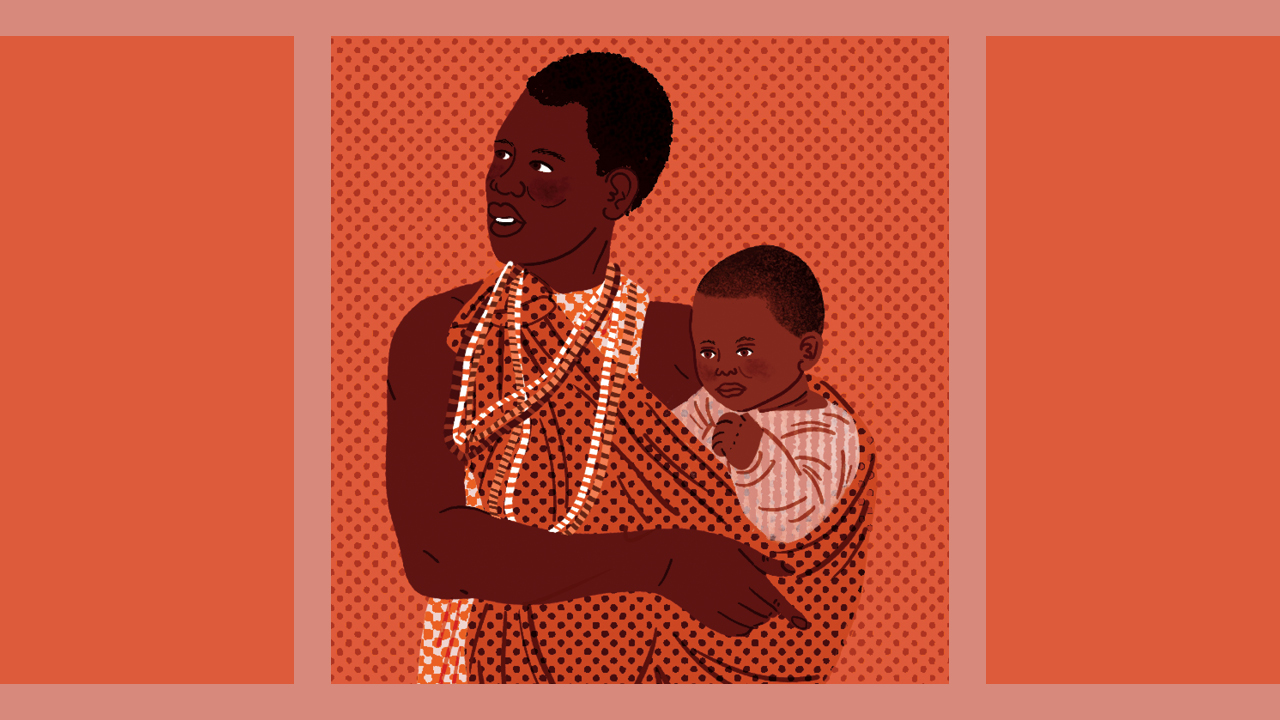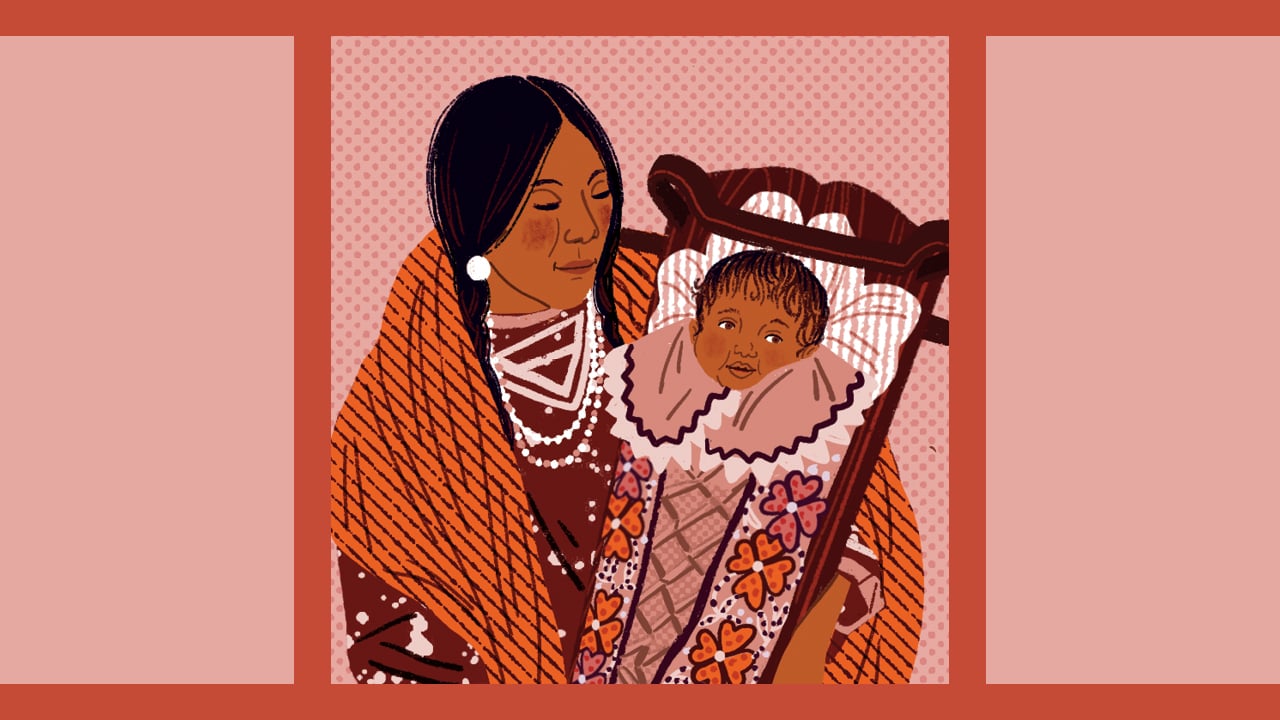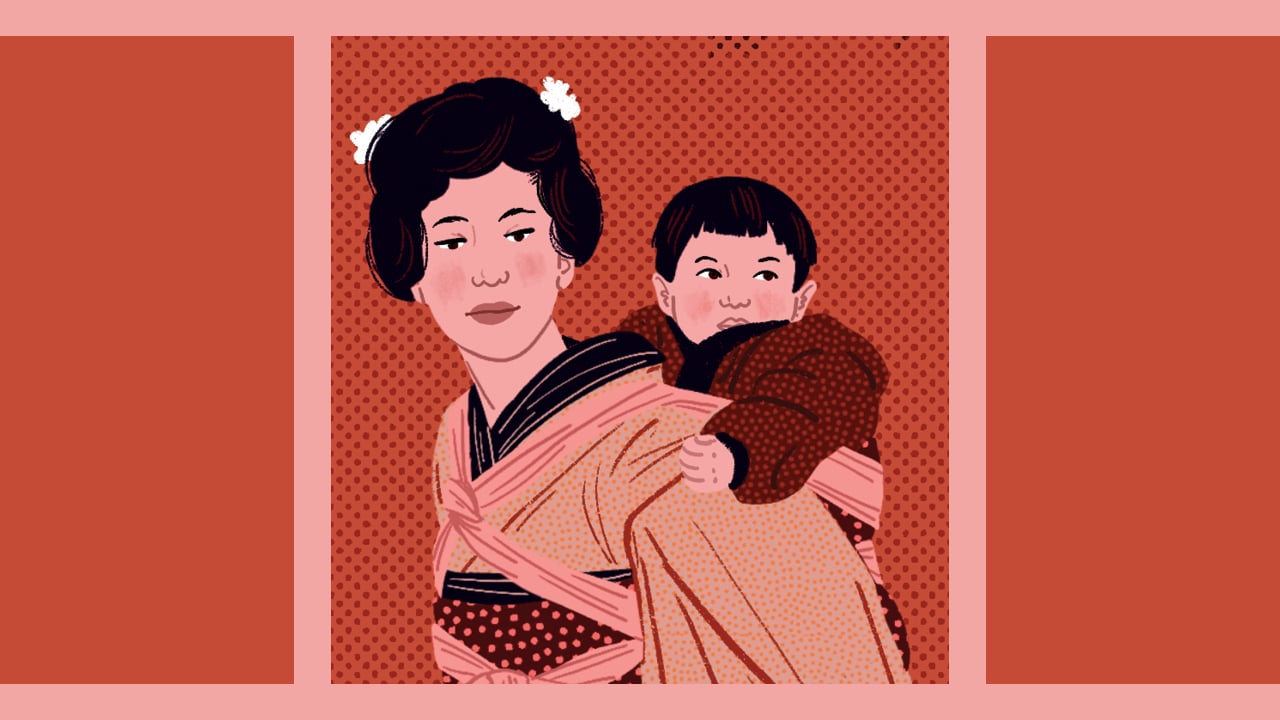Modern baby carriers that we see and use today are based on traditional baby carriers that have been used all around the world for hundreds of thousands of years. In fact, early humans may have started making carriers from animal skins, plants and other natural materials about half a million years ago as a necessity to keep their babies safe while attending to daily life. And according to James McKenna, an anthropology professor from the University of Notre Dame who studies mother-infant relationships, these carrying devices were some of the first tools ever created.
This is why it’s so important to respect the cultures our babywearing knowledge comes from, as this ancestral practice existed long before it was popularized in the West. In fact, babywearing has often been denied to Indigenous and racialized parents and children through the process of colonization and assimilation. It was seen as “primitive,” less culturally acceptable or somehow lesser-than, since historically, European, British and white North American mothers typically used prams and strollers to carry their infants.
In the end, we should be grateful to those parents who resisted being forced to abandon their living practices and who continue to carry their children in culturally specific ways, because without them, there would be no modern babywearing.
As a babywearing educator working with new parents and baby-gear stores, I also emphasize how important it is to learn to pronounce the names of these carriers properly. When we mispronounce or shorten the names, we contribute to the “whitewashing” of babywearing culture, erasing the true origins and traditions.
It’s impossible to summarize thousands of years of babywearing history spanning the entire globe and multiple cultures, but here’s a primer.
1. Snugli was not the first baby carrier
You may remember the corduroy Snugli baby carrier from your childhood—they were popular in the ’70s and ’80s. This vintage carrier was patented in 1969 by an American nurse, Ann Moore, when she first became a mother. She had worked for the Peace Corps in Togo, and wanted to emulate the carrying cloth that she had seen mothers use to keep their babies calm and content. Back in America and unable to figure out the traditional way of tying, she developed her own baby carrier based on what she had observed in Togo. (She is also one of the first babywearing entrepreneurs to responsibly acknowledge her inspiration.)
The very popular Ergobaby carrier has a similar origin story. In 2002, when Karin Frost was a new mom, she was disappointed with the comfort of the carriers available and started developing her own prototypes. Her first baby carrier design was born out of her study and observation of Indigenous people living near the Amazon River and an interest in attachment parenting, a parenting philosophy that encourages babywearing.

Illustration: Salini Perera
2. The origins of African cloth wraps
Traditional babywearing in Africa is still practised today, spanning from West to East Africa. Colourful printed cotton cloths are used to wrap little ones to their caregivers. In countries such as Tanzania and Kenya, babies are often wrapped on a wearer’s back or hip in a traditional kanga cloth; the fabric is spread over one shoulder and under the other and tied in front in a traditional sling carry pattern. In Ghana, babies are often carried on a caregiver’s lower back with the fabric secured around the caregiver’s torso, providing free movement of the arms. Depending on the region, a torso carry may be tied with a knot or simply tucked into itself to hold the baby in place. There are many different names for traditional cloth baby wraps—in Mozambique, it’s called a capulana, and in Nigeria, a wrapper or lappa.

Illustration: Salini Perera
3. If you’re Canadian, you should know about tikinaaganan and amautiit
Indigenous families in what we now label as Canada traditionally carried their babies in tikinaaganan and amautiit to keep their babies safe and close to their mothers. The tikinaagan is a traditional way of carrying a baby in a moss bag or cloth swaddle, which is then secured to a board for transportation on the wearer’s back. It could also be hung up somewhere safe while the parents could complete their daily tasks with both hands free. It’s also a beautiful object crafted by families to be passed down through the generations, and there is a resurgence among Anishinaabe and other Indigenous parents in an effort to connect with and preserve their culture.
For the Inuit, the amauti is a culturally protected parka design with a large hood or pocket in the back for a mother to safely carry her baby. It may also be called amaut or amautik (plural amautiit). The amauti parka is a significant part of Inuit identity. Styles may vary from region to region, but traditionally it was made out of animal skins, and today they are made out of polyester, cotton and duffle fabric. Modern amautiit still often use trim around the hood, made out of different furs.

Illustration: Salini Perera
4. Asian strap carriers or panel baby carriers are some of the oldest designs in existence
In Japan, some of the first carriers were strap carriers or obi sashes, where babies were tied on to a mother’s back like modern-day woven wraps. The Japanese also used onbuhimos, made out of soft fabric. Today’s modernized versions may also incorporate rings or buckles. This backpack carrier was waistless. Onbuhimo means “back-carrying strap” in Japanese. “Onbu” represents the act of carrying on the back, whereas “himo” means strap or rope.
In Korea, families use a podaegi to carry their babies. This traditional carrier appears as a quilted, wide blanket with a strap sewn across the top, and is intended for back-carrying. (Note that shortening the name to “pod” is inappropriate.)
Meh dai (in Cantonese pronunciation) or bei dai (in Mandarin pronunciation) are rectangles of fabric with straps coming out from each corner of the panel. Meh dai means “back-carrying strap,” where “meh” or “bei” means “carry on your back,” and “dai” means “strap.” Modern babywearing companies sometimes appropriate the name of this carrier into the label of their designs, but using the syllables paired with other words to create mash-up names is not OK. (For instance, Didymos has a meh dai–inspired carrier that they refer to in its marketing as DidyTai.)
In China, meh dai and bei dai were traditionally used to carry young babies and children similar to the Japanese and Korean strap carriers. These could be used on the front, but primarily were used on the back. Two of the straps were used around the caregiver’s waist, and the remaining two went over the caregiver’s shoulders or were tied under the arms as a torso carry.
5. Is all modern babywearing cultural appropriation?
Babywearing in itself is not cultural appropriation, but unfortunately, at times, elements of a baby carrier design, such as the fabric, style or name, may be appropriated. It’s a big topic in the babywearing world—time and time again, we see big companies making major missteps (and not always apologizing). In the simplest terms, carrier companies should not claim ownership over the practice, carrier types or techniques related to babywearing, and if they do, they are treading deep in the waters of cultural appropriation: when a dominant culture claims elements of a minority culture—such as their traditions, religion, social customs, creative practices or artistic forms—and uses them for profit or gain. This means the minority group is being exploited by the dominant one.
Sometimes a minority culture’s symbols are incorporated into the design with little understanding of the significance. Baby carrier companies may cross this line when marketing teams become inspired by “exotic” ideas, patterns or prints. They may think they are showing appreciation, and not appropriation, but when we really think about it, slapping a feather print or Chinese character on a baby carrier isn’t really elevating or honouring anything. (For Indigenous folks, feathers are held in high regard; eagle feathers are awarded to members of the community for significant achievements.) Taking a culturally significant element or symbol from a culture you don’t understand and reproducing it for fashion and sales raises ethical questions.
6. What are some examples of cultural appropriation?
Natibaby, a European baby carrier company, has named some of its designs Malta, Amazonia, Madagascar, Morocco, Tanzania and Chile despite having no relationship to these cultures. Artipoppe, the high-end Dutch baby wrap company, has infamously based some of its carrier patterns and names on East Asian cultures (1000 Cranes, Made in China, Origami Birds and Vishnu).
Didymos, a popular German baby wrap company beloved by many babywearing educators, has given some of its woven wraps and patterns insensitive names such as Orient, India, Inka and Indio (a racist and classist Spanish slur for Indigenous people). One of its prints was also remarkably identical to the traditional rebozo woven by the Zapotec people from Oaxaca, Mexico. (The company eventually renamed its weaves and offered a public apology for its insensitive naming choices.)
Earlier this year, Solly Baby, a newer, U.S.-based stretchy wrap company endorsed by lots of mom bloggers and Instagram influencers, happily announced that it had developed a “new” baby carrier design, and had a patent pending on it. (For those familiar with wrapping, the supposedly new carrier was basically a combination wrap and a ring carry, tied in the modified short cross carry pattern—something that isn’t new at all.) The design may appear innocuous, but to babywearing experts—and especially for the BIPOC babywearing community—it was instantly offensive and screamed cultural appropriation. Babywearing professionals were quick to point out that this style of carrier existed long ago and Solly Baby did not invent it, but the situation escalated when the company chose to selectively delete comments from its Instagram account to shut down voices of colour. If Solly Baby had done its research and consulted with these traditional communities, it could have mutually worked together to bring forth something great. Instead, it earned a lot of bad PR. Since then, Solly Baby has made two public apologies admitting its carelessness in launching the Loop carrier, dropped the patent and has pledged to do better.
There are many more examples—too numerous to list here. But if babywearing companies involved BIPOC experts in the design process and put in the necessary work and time needed for education, they would find it easier to recognize potentially offensive inspiration and honour the ancestral practice of babywearing instead of appropriating it.
